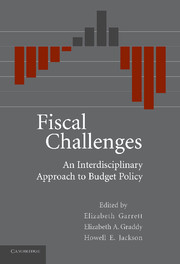Book contents
- Frontmatter
- Contents
- Preface
- Contributors
- PART ONE THE LAW AND POLITICS OF FISCAL POLICY
- 1 The Congressional Budget Process
- 2 Budget Gimmicks
- 3 Transparency in the U.S. Budget Process
- 4 European Experiences with Fiscal Rules and Institutions
- Part One Bibliography
- PART TWO UNDERSTANDING FEDERAL DEFICITS AND PUBLIC DEBT
- PART THREE BUDGETING AND FISCAL CONSTRAINTS AT THE STATE LEVEL
- PART FOUR INTERGOVERNMENTAL ASPECTS OF BUDGET POLICY
- PART FIVE JUDICIAL POWERS AND BUDGET POLICY
- Index
4 - European Experiences with Fiscal Rules and Institutions
Published online by Cambridge University Press: 23 December 2009
- Frontmatter
- Contents
- Preface
- Contributors
- PART ONE THE LAW AND POLITICS OF FISCAL POLICY
- 1 The Congressional Budget Process
- 2 Budget Gimmicks
- 3 Transparency in the U.S. Budget Process
- 4 European Experiences with Fiscal Rules and Institutions
- Part One Bibliography
- PART TWO UNDERSTANDING FEDERAL DEFICITS AND PUBLIC DEBT
- PART THREE BUDGETING AND FISCAL CONSTRAINTS AT THE STATE LEVEL
- PART FOUR INTERGOVERNMENTAL ASPECTS OF BUDGET POLICY
- PART FIVE JUDICIAL POWERS AND BUDGET POLICY
- Index
Summary
INTRODUCTION
The past two decades have seen a growing interest in fiscal rules. Fiscal rules specify numerical targets for key budgetary aggregates such as annual government deficits, debts, or spending. Such rules have a long history at the subnational level, and some countries, including Japan and Germany, have had less specific rules – such as the “Golden Rule,” which limits government borrowing to investment spending – at the national level for a long time. What is new is the application of specific annual targets at the national level. It has been part of the reaction to the rapid rise in public debt levels and the emergence of unsustainable public-sector budget deficits starting in the 1970s. Thus, fiscal rules aim at improving fiscal discipline and reducing government deficits and debts.
The Fiscal Consolidation Agreement adopted in Japan in 1981 was an early example of a fiscal rule. It set annual targets for the increase in major spending aggregates. In 1996, the Japanese government adopted a new rule under the Fiscal Restructuring Targets, and in 1997 it passed the Fiscal Structural Reform Act, which set annual spending targets for several years. The U.S. Congress adopted a fiscal rule in the Balanced Budget and Emergency Deficit Control Act (Gramm-Rudman-Hollings Act I) of 1985, which established numerical targets for the federal budget deficit for every fiscal year through 1991.
- Type
- Chapter
- Information
- Fiscal ChallengesAn Interdisciplinary Approach to Budget Policy, pp. 103 - 129Publisher: Cambridge University PressPrint publication year: 2008
- 6
- Cited by

